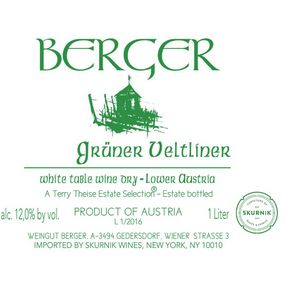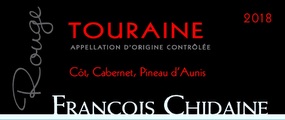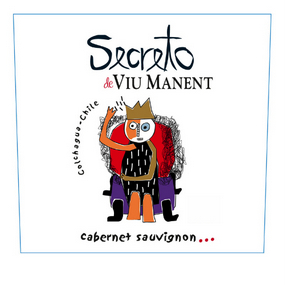BERGER GRUNER VELTLINER (ORGANIC)
CLEAN SLATE RIESLING (SUSTAINABLE)
ST. ROCH CÔTES DE PROVENCE ROSÉ (SUSTAINABLE)
CHIDAINE TOURAINE ROUGE (ORGANIC, BIODYNAMIC, AND NATURAL)
POT DE VIN MERLOT (ORGANIC, BIODYNAMIC, AND NATURAL)
VIU MANENT CABERNET SAUVIGNON SECRETO (SUSTAINABLE, VEGAN)
Berger Gruner Veltliner (Organic)
Weingut Berger is in the eastern part of the Kremstal, in the town of Gedersdorf. With Erich Berger’s guidance, the winery has implemented methods to produce wines that focus on varietal character and terroir. The white wines grow on steep loess terraces that characterize the landscape of the eastern part of the Kremstal. These terraces store heat during the day and reflect it onto the vines at night producing wines with unique fruity, fresh, and bright flavors.
The red wines are grown at the top of the hills where more humus-rich soils dominate and give the wines length, body, spice, and lush fruit. Vineyards are maintained according to the latest organic guidelines. In the winery, efforts are made to preserve the fruit character by using cultured yeast in combinations with slow fermentations that are temperature controlled. The white wines are then aged exclusively in stainless steel, while the red wines are matured in traditional oak vats.
Erich’s liter bottling of Grüner Veltliner has steadily improved over the last decade. It’s a perfect foil for the infectious drinkability that this variety is known for but has an extra level of clarity and complexity that is sometimes missing from this category. Fermented entirely in stainless steel from estate-grown, Loess-dominated vineyards in the Kremstal.

Clean Slate Mosel Riesling
Good dry German Riesling is the perfect anytime drink: it’s refreshing, has complex flavors, a nice fruit/acid balance that is brimming with minerality, and goes with foods that you wouldn’t normally associate with white wines.
Americans (and Brits) associate Riesling with sweet wines, but 90% of the Riesling grown, vinified, and drunk in Germany is bone dry. The German wine palate changed in the early 80s from sweet to dry, probably because of travels to Italy and Spain, and the wineries soon followed demand.
For the most part, American (and British) importers still believe that German wine means sweet, so 80-90% of the German Riesling imported to the USA is sweet. In fact, there are a lot of German weingut (wineries) who solely make sweet table wines for the American market!
Clean Slate is the product of a partnership between Moselland of Bernkastel, Germany, and The Winebow Group. Moselland is the largest vineyard owner in the Mosel and one of Germany’s top exporters of Riesling.
Clean Slate is sourced from selected vineyards throughout the Mosel region. Known for its steep slopes, the region’s exceptional climate and mineral-rich slate soil create the perfect growing conditions for this grape. The cool climate of Mosel’s northerly location allows grapes to ripen very slowly, while the slopes give the vines ideal sun exposure. Further protection comes with the Mosel River’s tendency to hold heat, keeping vines protected from getting too cold and creating a special microclimate for ideal ripeness levels. The thin, stony topsoil forces the vines to root deep through the rocks for water and nutrients, resulting in wines of excellent minerality and complexity. In the course of harvest,
Clean Slate makes daily decisions regarding which grapes to pick, based on ripeness and maturation in the different areas of the region. Winemaker Peter Meurer insists on the gentle handling of the grapes, which are then fermented and stored in stainless steel tanks under temperature-controlled conditions. All of this is critical to the development of the fresh peach, crisp lime, and subtle mineral flavors of Clean Slate’s wines — Peter’s exquisite expression of the region’s unique essence of Riesling terroir.
Clean Slate is evidence of Peter’s passion for the Mosel region and the Riesling grape. It has a clean, crisp taste profile with pure fruit flavors complemented by lively acidity, which is the trademark of Rieslings from Mosel-Saar-Ruwer. This appealing balance of fruit and crispness works well with a wide array of cuisines, making Clean Slate an exceptionally good match with food.
Saint-Roch Côtes du Provence Rosé
Saint Roch les Vignes is not an individual domain, but rather a modern cooperative production facility in Cuers serving most of the family winegrowers in that small hillside village, as well as those of neighboring Puget-Ville and Pierrefeu northeast of Toulon. Built in 1911 with the combined effort and assets of 143 growers, the winery was upgraded with state-of-the-art equipment in recent years and now handles vinification for more than 200 local vignerons.
The wines of Saint Roch are held to a higher standard than normal French cooperative wineries, as growers must not only adhere to Appellation Controlee laws, but also meet the quality standards of the Maitres Vignerons de Saint Tropez, who oversee Saint Roch‘s international sales and marketing. This group consists of seven highly-regarded, limited production Cotes de Provence domains headed by Edgar Pascaud, proprietor and director of Château de Pampelonne.
All fruit is destemmed. Direct pneumatic press juice. Short maceration on skins to attain Provence’s signature pale pink color. Fermentation takes place in temperature-controlled stainless steel tanks. No malo-lactic. Brief élevage on the lees in temp-controlled inox tanks before being filtered with diatomaceous earth and bottled in January after harvest.
This blend of Cinsault (50%) and Grenache (50%) has everything a Provencal rose should: delicacy, dryness, and drinkability! It smells of bright red berries, and the palate is lively and full of crisp, food-friendly acidity. Drink chilled, of course, with fish dishes. The Saint Roch les Vignes Côtes de Provence Rosé is France’s quintessential quaffer. This excellent import value is the perfect wine to share in the shade. Brisk, with a nice finish, a perfect porch pounder.
Chidaine Touraine Rouge
François Chidaine is one of the Loire Valley’s great success stories. After finishing viticultural school in the mid-1980s, François went to work alongside his father, Yves, who had only four hectares of rented vineyard land in the appellation of Montlouis, in the Touraine. When Yves retired in 1989, he passed the torch to François. Early on, François developed clever contracts with the owners of the vineyards he worked, allowing him an option to buy should the property ever come up for sale. In 1999, his wife, Manuéla, joined him and set up La Cave Insolite, a tasting room, and wine shop. Soon after, he started experimenting with organic and biodynamic farming, and by 2003, he was certified in both methods of farming. When in 2002, he and his cousin Nicolas Martin bought Vouvray’s prestigious Clos Baudoin, and in 2006 he bought several of the parcels he had been renting, this small artisan farmer became one of the Loire Valley’s most serious players.
The majority of François’ terroirs are situated in Montlouis, with more in neighboring Vouvray, and additional land in the Touraine appellation, totaling more than 30 hectares. Before Montlouis had earned its own AOC in the 1950s, it was considered the lesser part of Vouvray due to the higher quantities of gravel and sand in the soil. In truth, there is a striking minerality derived from the flinty soils of Montlouis that has since given the appellation its own reputation for excellence. While François is a darling of the organic and biodynamic movements, he is by no means interested in indicating as much on the labels. Instead, he focuses on keeping his 40- to 80-year-old vines healthy and yields low, averaging 35 hl/ha. He follows the almanac developed by biodynamic legend, Maria Thun, which looks at both the solar and lunar calendars to establish the best timing for specific vine treatments. He and his team harvest the entire crop by hand.
The grapes are pressed gently and are vinified on wild yeasts in both barrels and demi-muids. François seeks slow alcoholic fermentations that last all winter long and avoids malolactic fermentation when possible. The cold limestone cellars allow the wines to develop more layers of complexity, which are simply unattainable when the process is rushed. Slow cuvaisons produce an antioxidant blanket of carbon dioxide, which allows the winemaker to put off adding sulfur to the wine, thereby lowering the total amount needed. Many of the wines age for 12 months on their lees before bottling. The sparkling Montlouis Brut also goes through alcoholic fermentation in demi-muids for more than five months, after which it is bottled and aged on its lees for 12 months to produce a delicious Chenin Blanc likely to impress devoted Champagne drinkers.
In addition to their Montlouis and Vouvrays, the Chidaines also produce some stunning red and white wines from their Touraine vineyards just outside the Montlouis AOC. With such special care given to every step of the process, it’s no wonder that they sell out their stock within just a few months of bottling. We are lucky to receive these wines, as they remain some of the best values on the market today..
Produced from equal amounts of Côt (what Malbec is called in every region of France, except Bordeaux), Cabernet Franc & Pinot d’Aunis (a rare grape from the Loire that is the red variant of Chenin Blanc: Chenin Noir!)
From 100% estate biodynamically farmed vines located just north of the Cher river near the villages of Montrichard & Chissay-en Touraine, this is a very promising wine. Known primarily for making some of the greatest white wines in the Loire region, Chidaine has been farming these vineyards for several years. Good dark concentration of fruit where neither varietal dominates but rather complements the others. The faintly mineral nose shows notes of pepper melded with the red fruit and leads into a wine with medium tannins, good concentration and length. Not a heavy wine, it has plenty of character, and bright acidity, which makes it a classic food wine to go with difficult pairings.
As with all Loire reds, chill this down (45 mins or so in the fridge) to reveal its wonderful flavors and ease of drinkability.
Indigenous yeast fermented, stainless steel vat fermented and aged. Grapes are grown on gravelly loam, chalky limestone, and clay soils.

Situated in Malepère, the most westerly region of the Languedoc, Château Guilhem was built in 1791.
Then the property of the Marquis de Auberjon, it was bought by the Guilhem family in 1878. Bertrand is the fifth generation of his family to run the estate. The 85 acres of vineyards are planted mainly to Bordeaux varieties— Cabernets Sauvignon and Franc, Merlot, and Sauvignon Blanc— with some Chardonnay.
Despite the vineyards’ proximity to the Mediterranean, the climate here actually sees quite a bit of influence from the Atlantic; in addition, the soil here is atypical of the rest of the region, with a high proportion of calcareous sandstones. These stones help the soils to retain moisture over the winter so that the vines can flourish in the summer. The grapes are grown organically, with some biodynamic parcels as well, out of respect for both the vines and for the people who work them. The cellar was built in the late 19th century; old casks and concrete tanks stand next to modern stainless steel vats. Bertrand pulls both from older traditions and modern ideas in order to produce fresh, aromatic wines.
In 2015, chateau owner Bertrand Gourdou was searching through an old desk when he came across a label that his grandfather had made in the early 1970s; that wine was called “Le pot-de-vin” which, in French, translates to “the bribe”, which for that era was an audacious play on words for a wine label!
This label inspired Bertrand to make a simple, natural wine: biodynamically grown fruit, fermented with native yeast and with a negligible dose of SO2, made in concrete tanks built by his grandfather. The word “pot” also references the old-style bottle shape!
100% Merlot from the IGP Pays d’Oc, made with no oak in a light-to-medium-bodied style with gloriously fruit, freshness, and length. It is, simply put, the quintessential French bistro red.
Viu Manent Cabernet Sauvignon Secreto
After working as a wine merchant alongside his father and brother since the 1930’s, Miguel Viu Manent made the decision to branch out on his own in 1965, purchasing a historic vineyard and winery in Chile’s Colchagua Valley. The estate was and still is one of the most well-exposed sites in the region, and it included 150 hectares of pre-phylloxera massal selections from France. This company provides us with wines we consider the best value wines in the country (see “Reserva line), forward/experimental options (see “Secreto” line), some of the most solid “under $20” varietal wines you’ll find anywhere in the world (see “Gran Reserva” line), site specific/terroir driven releases.
After nearly 100 years this firm is still family-owned and operated (a rarity in Chile, especially for a winery of this size), all farming is certified sustainable, and two of Chile’s top names consult with the winery on a permanent basis – Roberto Pizarro (vineyard management) and Paul Hobbs (winemaking).
Vines that are more than a century old supply the fruit for this hugely drinkable Cabernet Sauvignon, which contains 15% of other grapes in a field blend. Rich, scented, and lightly oaked, it has some aromatic spices and smooth pastille fruit.
Intense cherry red in color. The nose stands out for its fruitiness and primarily offers aromas of strawberries, raspberries, and cherries along with a light note of spices. The palate is intense, with good volume, silky tannins, and rich acidity, ending with a long and pleasing finish.





